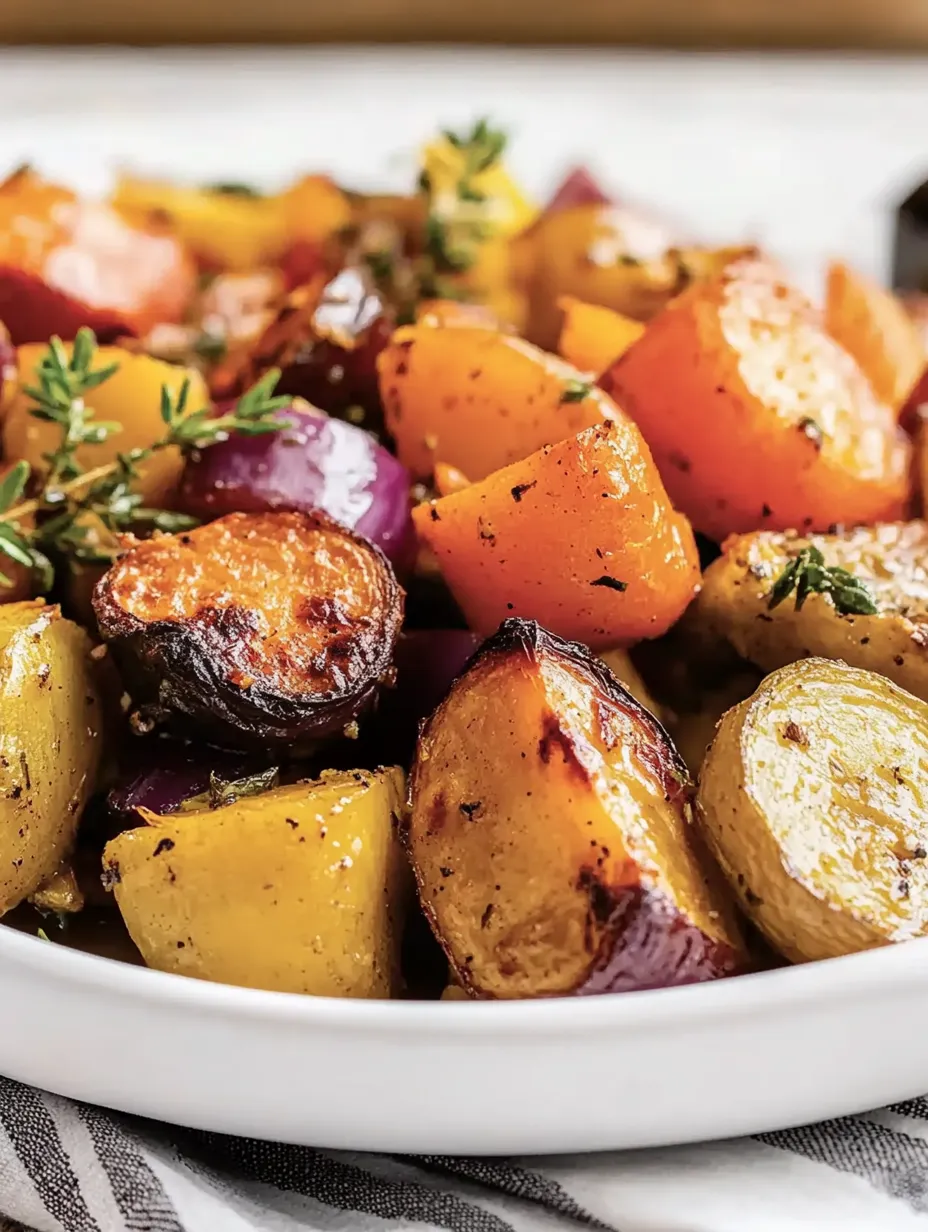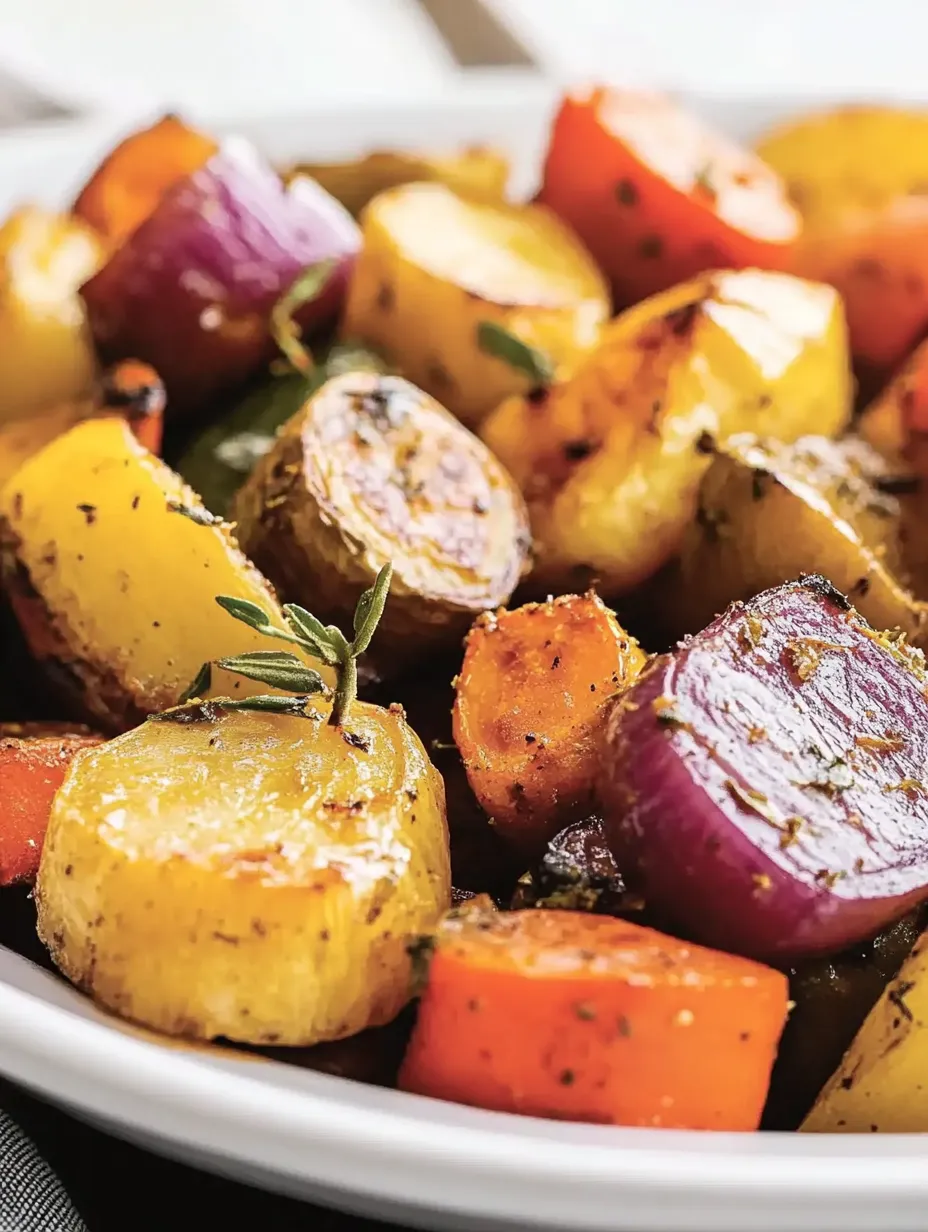 Pin it
Pin it
Roasting transforms ordinary vegetables into caramelized gems of flavor and texture. The dry heat of the oven creates perfectly crisp edges while maintaining tender centers, bringing out natural sweetness and developing complex flavors impossible to achieve through other cooking methods. This versatile technique turns whatever seasonal vegetables you have into a memorable side dish that often steals attention from the main course.
Last autumn, I served these roasted vegetables at a dinner party, and a confirmed vegetable-avoider asked for seconds. Their spouse later confided that they'd purchased a sheet pan specifically to recreate the recipe at home. Those crispy, caramelized edges have a way of converting even the most committed veggie skeptics.
Perfect Produce Selection
Root Vegetables
- Baby potatoes: Should feel firm without soft spots or sprouting
- Sweet potatoes: Need smooth skin without blemishes for best results
- Fresh carrots: Should maintain flexibility without brittleness
Tender Vegetables
- Brussels sprouts: Require tight, compact heads for even cooking
- Asparagus stalks: Should stand straight with firm, closed tips
- Bell peppers: Must feel heavy for their size indicating freshness
Aromatic Elements
- Red onions: Bring natural sweetness that intensifies with roasting
- Fresh garlic cloves: Create flavor foundation throughout the dish
- Balsamic vinegar: Provides depth that enhances natural vegetable sugars
 Pin it
Pin it
Through countless preparations, I've learned that truly fresh vegetables make an extraordinary difference in the final result. My local farmer taught me to gently squeeze Brussels sprouts—they should feel like tight little fists. This simple test has never steered me wrong in selecting sprouts that roast beautifully.
Essential Method
Vegetable Preparation
Begin by washing all vegetables thoroughly under cool running water. Pat completely dry with clean kitchen towels, as excess moisture prevents proper caramelization. Cut vegetables thoughtfully, considering their natural cooking times. Create similarly sized pieces to ensure even cooking, making slower-cooking root vegetables slightly smaller than quick-cooking items.
Seasoning Application
Place prepared vegetables in large mixing bowl providing ample space for tossing. Drizzle with extra virgin olive oil and balsamic vinegar, ensuring even coverage. Add minced fresh garlic, dried herbs, and seasonings. Toss gently but thoroughly using clean hands or wooden spoons until every piece shows consistent coating.
Roasting Technique
Arrange seasoned vegetables on parchment-lined baking sheets in single layer without overcrowding. Position racks in upper and lower thirds of oven preheated to 425°F. Place sheets in oven, rotating their positions halfway through cooking. Toss vegetables gently after twenty minutes to promote even browning.
Final Touches
Remove vegetables when edges show deep caramelization and centers test tender when pierced. Transfer immediately to serving dish, scraping any crispy bits from parchment. Taste and adjust seasoning if needed while still hot. Finish with fresh herbs if desired for color contrast and bright flavor.
My first attempt at roasted vegetables taught me a hard lesson about overcrowding when everything steamed instead of caramelized. A chef friend later explained that vegetables need "personal space" to develop those coveted crispy edges. Now I always use two sheet pans even for smaller portions, ensuring every piece has room to shine.
Professional kitchens often roast vegetables at even higher temperatures, but I've found 425°F provides the perfect balance for home ovens. This temperature creates beautiful caramelization while preventing any bitter burnt spots that can develop at higher heat. The trick lies in patience—allowing enough time for natural sugars to develop while monitoring for perfect doneness.
 Pin it
Pin it
Perfect Pairings
Main Course Matches
These roasted vegetables complement grilled meats beautifully, especially herb-crusted chicken or roasted pork loin. Consider serving alongside baked fish for lighter meal options. The vegetables also stand alone as main course for vegetarian dinners when served over quinoa or brown rice.
Sauce Suggestions
Create simple lemon herb sauce for drizzling just before serving. Consider homemade romesco sauce for Spanish-inspired variation. Offer balsamic reduction on side for those wanting additional flavor intensity.
Garnish Options
Finish with freshly grated Parmesan cheese for savory depth. Sprinkle with toasted pine nuts or pumpkin seeds for textural contrast. Add fresh herbs like basil or dill just before serving for bright color and flavor.
Creative Adaptations
Seasonal Variations
Summer version features zucchini, yellow squash, and cherry tomatoes. Autumn preparation includes butternut squash and parsnips for hearty appeal. Winter adaptation incorporates cauliflower and multiple root vegetables.
Global Inspirations
Mediterranean style uses oregano, lemon zest, and finished with feta cheese. Indian-spiced version incorporates curry powder and cumin seeds. Mexican variation features chili powder and lime juice finish.
Textural Additions
Include whole garlic cloves that roast to sweet tenderness. Add cherry tomatoes during final fifteen minutes. Consider small mushrooms for additional savory elements.
Storage Success
Cooling Process
Allow vegetables to reach room temperature before storing. Avoid covering while hot to prevent condensation from softening crispy edges. Use shallow containers for quicker cooling and better texture preservation.
Reheating Method
Warm in 375°F oven until heated through, about 10 minutes. Avoid microwave reheating which creates soggy results. Consider reheating only portion being served immediately.
Future Planning
Prep extra vegetables during initial cutting for next-day roasting. Store cut vegetables in water to prevent oxidation. Label containers with contents and date for proper rotation.
 Pin it
Pin it
The most valuable lesson in my roasted vegetable journey came from an elderly Italian neighbor who insisted on waiting until vegetables developed deep golden edges before removing them from the oven. "The color tells you when they're ready," she would say, showing me how to look for that perfect caramelization that indicates natural sugars have developed fully. Her patience-first approach transformed my understanding of vegetable roasting, proving that sometimes the simplest techniques require the most restraint to achieve perfect results.
Frequently Asked Questions
- → Why cut vegetables different sizes?
- Different vegetables cook at different speeds. Cut slower-cooking ones smaller.
- → Can I use different vegetables?
- Yes, use any vegetables you like, adjusting size and cooking time accordingly.
- → Why use two baking sheets?
- Prevents overcrowding which leads to steaming instead of roasting.
- → Can I make these ahead?
- Best served fresh, but can be reheated. They'll be softer when reheated.
- → What temperature is best?
- 425°F gives nice caramelization while cooking through properly.
